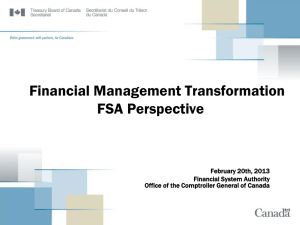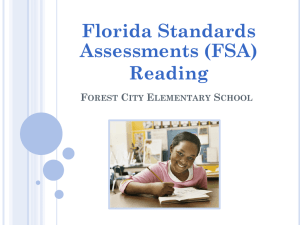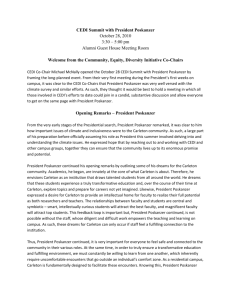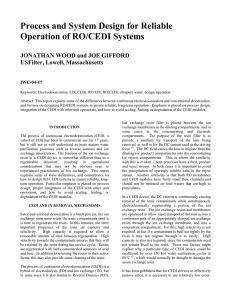Financial Management Business Solutions Pilot (FM-BSP
advertisement
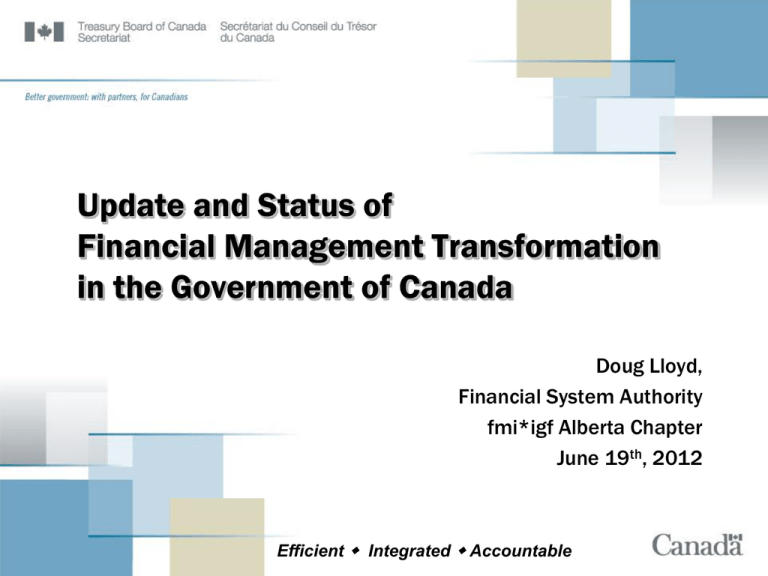
Update and Status of Financial Management Transformation in the Government of Canada Doug Lloyd, Financial System Authority fmi*igf Alberta Chapter June 19th, 2012 Efficient Integrated Accountable Agenda Where we are today Financial Management Services Financial System Authority (FSA) Initiatives • Common FM-BP Initiative (FM-BP) • Common Enterprise Data Initiative (CEDI) • Common Financial Management System Configuration (FM-SC) The Convergence Path Target Financial Management Environment for GC 2 Who is FSA? OFFICE OF THE COMPTROLLER GENERAL (Treasury Board Secretariat of Canada) Comptroller General’s Office Financial Management Sector Internal Audit Sector FSA is not technology focused 1. FMS – Assistant Comptroller General’s Office 2. Financial Management Policy Directorate 3. Financial System Authority (FSA) 4. Government Accounting Policy and Reporting 5. Capacity Building and Community Development 6. Financial Management Strategies, Costing and Charging Acquired Services and Assets Sector FSA focus is on functional business requirements 3 FSA Vision and Services 4 FSA Linkages in GC Departmental Operations GC-wide Direction Departments (DM/CFO, Management) Service Providers Cluster Groups Mazankowski Tellier Report Requirements, Expertise Reports to the Prime Minister on the Public Service Services Sector Finance Council Recommendations Strategic Direction Fulfillment Common Processes FSA Initiatives for GC • FM-BP • CEDI • FM-SC Policy Centres & Central Agencies Validation Enablement Policies, Directives, Standards, Guidelines, Tools Blue Ribbon Panel Standardization through Collaboration Annual Budgets Horizontal Initiatives CEDI STSI Grants & Contributions 5 Where We Are Today GC Financial Management Service Delivery Transformation GC Priorities GC Financial Mgmt. Fiscal Challenges “Tradition of Excellence” Integration Challenges Administrative Services Review GC FM Community Public Service Renewal Financial System Authority (FSA) 6 Objectives of the Policy and Directive on the Stewardship of Financial Management Systems (FMS) • “Common business processes and common data ensuring financial information is consistent and reliable” • “Provide functional guidance for FMS. (Common Configuration - but not the technology or software to be used)” • “Interoperable financial systems. (Interoperable: able to work efficiently and exchange information with other systems)” • “Clarify the roles and responsibilities for Deputy Ministers, Chief Financial Officers and other key stakeholders” Link to Policy = http://www.tbs-sct.gc.ca/pol/doc-eng.aspx?id=17589 Link to Directive = http://www.tbs-sct.gc.ca/pol/doc-eng.aspx?id=17590 7 Financial Management in the Government of Canada 8 Where we are today GC Priorities & Initiatives Priorities •Accountability • Transparency • Value-for-money Initiatives •Public Service Renewal •FM Policy Renewal & MAF Alignment •Administrative Services Review (ASR) 9 Financial Management in the Government of Canada • Tradition of excellence – Continuous improvement – High standards and ensuring public funds are used diligently • Greater focus on stewardship – DM approval and sign-off of departmental financial statements – Policy on Internal Controls and formalization of CFO role – Increased expectations of accounting and control functions • Our business is evolving; increased demands to: – Strengthen the financial management function – Reinforce the principles of prudence and probity – Improve the quality and timeliness of integrated financial information – Provide accessible information to demonstrate strong financial management of public resources 10 Financial Management Services Financial Service Profiles Service Levels Costing, Pricing and Value Policy Common Enterprise Data Initiative (CEDI) Directive Common Financial Management Business Process Initiative (FM-BP) Common Financial Management System Configuration Initiative (FM-SC) The Convergence Path PRESENT SITUATION (2012-2013) SAP Financial Management TRANSFORMATION ‘LENS’ POST-TRANSFORMATION AND CONVERGENCE: (after 2014) TBS IC HC CEDI (Common Data) Oracle TC CDFS RG FM-BSP service point C FM-BP (Common Processes) FM-SC (Common Configuration) SDA Service Point Project G/X SDA Service point CHRT FM-BSP service point A FM-BSP service point B Futur e FM-BSP service point D Futur e FM-BSP Service Point Project FreeBalance • 5 Departmental Financial Management Systems • 30 – 40 configurations • Over 100 departmental charts of accounts • Differing services and standards • 1 DFMS used at a variety of service points • 1 standard configuration • 1 departmental chart of accounts • Common services and standards 12 Common FM-BP Initiative Goal: To develop an integrated framework of ‘should be’ common processes that standardize and modernize the delivery of financial management. Deliverables: • 20 TBS Guidelines for GC departments 13 The Common FM-BP Initiative Goal: To develop an integrated framework of ‘should be’ common processes that standardize and modernize the delivery of financial management Approach: OCG sponsored in collaboration with departments and agencies, financial systems clusters, policy authorities and service providers Deliverables: • Guidelines which will provide: Standardized process definitions – System- independent, modular, interoperable – Common to all departments and agencies – Describes roles and responsibilities in detail “RACI” data analysis includes identification of: – Responsible, Accountable, Consulted, and Informed resources; and – Authoritative data sources Process Flows – Flow diagrams 14 Build a Collaborative Community 15 GCs Common FM-BP models Planning Budgeting & Forecasting • Manage Planning & Budgeting • Manage Forecasting & Budget Review Revenue & Accounts Receivable • Manage Revenue, Receivables & Receipts • Manage Interdepartmental Settlements • Manage Collection of Overdue Receivables Expenditure & Accounts Payable • Manage Procure to Payment • Manage Travel • Manage Other Payments • Manage Distribution and Maintenance of Acquisition Cards HR/Finance Interactions • Pay Administration Materiel/Finance Interactions • Manage Other Capital Assets • Manage Real Property • Manage Inventory Transfer Payments • Manage Grants & Contributions Data • Manage Vendor Master Data File • Manage Delegation of Financial and Spending Authorities • Manage Departmental Chart of Accounts • Manage Customer Master Data File Integration • Manage Post-payment Verification • Manage Financial Close Models in bold italic are available now. 16 Sample Level 2 Process Flow 17 Sample Level 3 Process Flow Comprehensive Process Flow Integrated view across all FM-BP processes Linkages to process description and RACI Consideration of controls 18 Sample Level 3 Sub-Process Description “(…)The vendor sends an invoice, which could be received by the program area or in the accounts payable or finance department, depending on the arrangements established in the contract. Account verification provides the necessary evidence required to demonstrate that the work has been performed, the goods supplied or the services rendered, relevant contract or agreement terms and conditions have been met, the transaction is accurate, and all authorities have been complied with[1]. Primary responsibility for verifying individual accounts rests with managers (financial management) who have the authority to confirm and certify entitlement pursuant to S.34 of the FAA[2]. These steps rely upon the good/services receipt process described in section 3.3.1, the approved contract (output from section 3.2.1) and the vendor invoice. All payments and settlements must be certified pursuant to S.34 of the FAA. Credit memos are reviewed following the same process to invoices received. To ensure separation of duties, the transaction authority and the certification authority (i.e. pursuant to S.34 FAA) should be assigned to separate individuals[3]. If the process or other circumstances do not allow such separation of duties, alternate control measures should be implemented.[4] (…) Comprehensive Process Description [1] Directive on Account Verification, Section 3.3 [2] Directive on Account Verification, Section 6.2 [3] Directive on Delegation of Financial Authorities for Disbursements, Section 6.3 [4] Ibid. Linkages to Process Flow and RACI Integrated view across all FM-BP processes Reference to applicable policy or regulation Identification of Roles and Responsibilities Consideration of controls 19 Common Enterprise Data Initiative (CEDI) Goal: To establish a common financial language, provide governance and standards for financial information and data, and facilitate the delivery of policy instruments and repositories necessary to enable interoperability among stakeholders. Transaction data Deliverables: FY14-15+ •6 TBS Standards •and several TBS Guidelines Reference data Other financial master data Canadians FY12-14 Re lts su Pla n Standard on Customer Record Standard on Vendor Record FY10-11 Departments Managers Standard on Procurement Item FY11-12 Parliament Actual Employees Central Agencies Guideline - Common Line Object Codes (Draft) Standard - Dept Common Chart of Accounts (Draft) 20 CEDI - Introduction and Context What is Common Enterprise Data? • Common Enterprise Data represents key data entities/elements supporting an organization’s business – e.g. for Financial Management business a key data entity = Vendor code • Common Enterprise Data characteristics are: – Permanent or lasting nature – Relatively static, not subject to frequent change – Accessed / used by multiple business functions, business processes and system applications CEDI - Introduction and Context Why Common Enterprise Data? •Data intended as “common to the Enterprise” is not consistently managed e.g.: – is often “translated” (if the position number is 1900/01/01 this person had an acting position) – has imbedded meaning (if the first character of the employee code is a “1” they live in Ontario) breaking the “information chain”, resulting in misinterpretation, wasted effort and errors. Information Chain Data Information Knowledge Common Enterprise Data – Enables a successful “Information Chain” – Is foundation needed to institute improved management of financial data – If managed as an Enterprise asset, it can be reused as intended – Establishes consistency of data needed for interoperability and horizontal analysis CEDI – Approach Meet CEDI’s objectives through a series of projects that evolve into a Financial Data Management Program Data Standards Framework Sample Projects Definitions & Standards Controls & Data Management Policy and Directives And standards Governance Data Integration Chart of Accounts Vendor & Customer Record Materiel Record Common Table Values Financial Management Data Components Other Master Data GC Enterprise Data Architecture Business Processes Resource Management System (ERP) Enterprise Reporting and Resource Management Requirements Proactive Disclosure Horizontal Initiatives Enterprise Perform. Departmental Perform. Operational Reporting Public Enquiries Parliamentary Reports Planning/Budgeting Contracting/Procurement Resource Utilization HR Financial Performance/Outcomes Corporate services CEDI – Communication Principles • • • • • • • • Avoid information “overload” Provide clear and consistent messages Repeat messages through various channels Create demand for information about CEDI encouraging stakeholder groups to seek information rather than OCG pushing it at them. GCpedia Tailor communications to audiences. Use communications style and vocabulary appropriate to a particular audience Manage expectations Solicit, listen to, and respond to feedback from stakeholder groups Begin simple and expand in complexity as necessary CEDI - Prioritize Stakeholder Groups “Data Providers” Data Supply • Departments and Agencies Financial Operations • Program delivery in departments • PWGSC • External • Service Providers “Information Consumers” Information Demand • Enterprise: Reporting / Obligations • Enterprise Analysis • Finance Senior decision makers • I.T. Senior decision makers • HR Senior decision makers • MM Senior decision makers “Key Enablers” • Policy Makers • GC Internal Services • Advisors to senior decision makers • Strategic Advisors and Associated Tactical Advisors: Headquarters (HQ), Working Groups, Regional Councils / Working Groups CEDI Approach & Maturity • CEDI establishes a framework for proactively managing financial data and information as a strategic asset and enterprise enabler. • Over time, CEDI supports the progression of the GC towards a more mature capability for management of financial information. Data Management Maturity Model Value Source: Enterprise Data Management Council Resource Utilization VALUE GAP Initial Reactive Defined Managed Optimized Level 1 Level 2 Level 3 Level 4 Level 5 Capability Maturity 26 Financial Management System Configuration (FM-SC) The purpose of the Financial Management System Configuration Initiative (FM-SC) is to identify a set of departmental financial management system (DFMS) configuration requirements for the Government of Canada (GC) within the context of its current legislative and policy framework. The FM-SC is intended to apply to all departments and agencies as defined in section 2 of the Financial Administration Act (FAA). The end result of this initiative will be the Financial Management System Configuration Guideline. Per the Directive on the Stewardship of FMS: Role of the Chief Financial Officer 6.1.3 Implementing FMS cluster group system configurations and OCG-endorsed system functionality as they are established or made available from time to time. Role of the Chair of the FMS cluster group management board 6.4.1 The chair of the cluster group management board is responsible for evolving the cluster configuration in alignment with the criteria established by the OCG for cluster configurations. 27 Common Financial Management System Configuration (FM-SC) Layout of Each Component INTRODUCTION PURPOSE SCOPE PRINCIPLES APPROACH COMPONENT DETAIL PROCESS REQUIREMENTS DATA REQUIREMENTS REPORTING REQUIREMENTS INTERFACE REQUIREMENTS INTEGRATION REQUIREMENTS 29 The Way Forward Today: We are converging, standardizing and making things more common for everyone to use and re-use in the Government of Canada and other jurisdictions Tomorrow: We envision managing the GC as a single enterprise with a variety of financial management services using various delivery options. The actual delivery model(s) have not been determined. FSA is: • Leveraging technology to collaborate and engage stakeholders • Developing an FMS solution for Small Departments and Agencies • Working on a catalogue of FM services • Exploring how Cloud Computing could enable delivery of FM • Dialoguing with US & International counterparts to share best practices Financial Management Service Framework Financial Service Profiles Service Levels & Service Guarantees Costing, Pricing and Value Policy Directive Common Enterprise Data Initiative (CEDI) Common Financial Management Business Process Initiative (FM-BP) DATA PROCESSES Common Financial Management System Configuration Initiative (FM-SC) CONFIGURATION FM Transformation Timeline April 1 2010 April 1, 2011 PSFMS April 1 2012 April 1 2013 Implementation Infinity and beyond Ongoing FM-BP Issue 1 Guideline Issue 10 Guidelines CEDI Issue 1 Guideline Issue 4 Standards FM-SC Issue 1 Guideline Issue 10 Guidelines Other Standards and Guidelines Subsequent Phases MAF Ongoing Cluster Plan Review Phase 1 Financial Management Service Profiling for GC Service Profile Process Information Configuration 33 FM Transformation Vision • • • Core configuration for small organizations, large complex organizations and configuration that includes Grants & Contributions Templates that are transferrable across the GC to be used by other groups of “DFMS clusters” Complies with CIOBs standards on ERPs (i.e. SAP); common financial management business processes, information and data. Standard on ERP systems Deficit Reduction Action Plan FM TRANSFORMATION Administrative Services Review (ASR) STAKEHOLDERS Large Complex Organizations OTHER Small Organizations To Be Determined FISI PWGSC •Chief Information Officer Branch •Office of the Comptroller General •Public Works Government Services Canada FUTURE Large Complex & (incl. Grants & Contributions) FSA Strategic Roadmap to “Finance in the Cloud” Domain BUSINESS • Processes • Goals & Objectives • Outcomes Finance / Materiel Interoperability • OCG • OCG • FM-BP • OCG • OCG • CEDI • FM-SC INFORMATION • Flows • Data Dictionary APPLICATION • Business Functionality • Workflow • IT Foundation (S/W) • OCG • OCG • CIOB • CIOB • IT • CIOB • CIOB TECHNOLOGY Current Projects 35 Roadmap to “Finance in the Cloud” Technology (Gen’l) Cluster Central Agencies Dept’s • • • • • FSA Vendor Parliament Other Countries • • • • • Needs Deficiencies Success factors What works well Performance targets • Analysis • Rec’n on improvements • Roadmap Maintenance • • • • • Provinces Private Sector Fin Prof’l Bodies Best Practices Success Stories What doesn’t work well Options Roadmaps Rec’s to enhance Business case(s) Design Arch. solution Updated roadmap Build Enhanced Model Target Model Proposed Existing Model Version 1 Updated Model Version 2 36 Why a Service Catalogue? Purpose of a service catalogue: The document that specifies the services, the costs and associated service levels provided in an organization Customers Provides the one source of information for services Clear service acquisition process Outlines service standards and sets expectations Consistent levels of service and cost information Communication Tool Organization Transparent service offering De facto SLA Allows processes to be developed linking to the services levels Costs can be established in support of those services Creates organizational stability 37 Typical Structure ‘Must include’ sections of a service catalogue: 1) Service overview Service name, description, features and functions, and availability 2) Description Full outline of service, resources for additional support, and links to FAQs and self help information 3) Acquisition process Standard contacts for support staff, information on submitting service requests Includes how to use the service, key contacts, web logins 4) Service Levels Service guarantees, recourse for service failure 5) Pricing Cost of services, support charges, and other rate information Options related to the service 38 Service Profile Categories for FM Services 39 Example of FM Services in the area of “Financial Operations” Finance Service Category Corporate Finance Financial Operations • Transaction Processing • Financial Reporting • Asset Management Financial Management Services Planning & Budgeting Financial Systems Related Services Category Financial Operations includes the day-to-day activities required to support the activities of the Department, including: •Transaction Processing – includes accounts payable, accounts receivable (where appropriate), expenses reimbursement, payroll processing, journal voucher/budget transfer processing, expenditure/purchasing card program management, interdepartmental settlements (where appropriate), and grants & contributions disbursement (where appropriate). •Financial Reporting – includes preparation of mandatory financial statements and financial reports for central agencies. •Asset Management – entails financial stewardship over the Department’s assets including monitoring of asset life and asset value. 40 Other Jurisdictions USA: - new approach for managing FM - Unable to obtain a clean opinion - Very interested in our progress - Looking to innovate and standardise - Exploring Cloud Computing for FM services Canadian Provinces: - Alberta, BC and Ontario have shared services delivery in place Other G7: - Canada co-hosts International Colloquium with US - Canada is considered a leader in FM (12 clean opinions) Discussion and Questions 42 Contact information: Doug Lloyd – Executive Director, FSA doug.lloyd@tbs-sct.gc.ca 613-952-3208 Marcel Boulianne – Communications Director, FSA marcel.boulianne@tbs-sct.gc.ca 613-946-4512 FSA Website (for public): http://www.tbs-sct.gc.ca/fm-gf/abu-ans/standard-eng.asp GCpedia website (for GC only): http://www.gcpedia.gc.ca/wiki/Fsa 43 44 44
